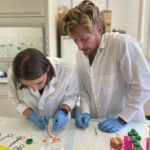The Tjalkens Laboratory investigates neuroinflammation and the role of glial cells in neurodegenerative diseases such as Parkinson’s Disease. Projects are investigating the molecular regulation of innate immune inflammatory responses in brain glial cells, as well as the impact of exposure to environmental neurotoxins on the etiology of neurodegenerative disease. Additionally, we are examining how infection with neurotropic viruses triggers inflammation and protein aggregation in neurodegenerative disorders. Transgenic models and high content fluorescence imaging are central techniques used in our laboratory to study these phenomena.
research project
Neuroinflammation in Parkinson's Disease
Innate immune signaling in glial cells results in production of neurotoxic inflammatory factors that are associated with neuronal injury and protein aggregation in Parkinson’s disease. We are using transgenic animal models and primary cultures of microglia and astrocytes to understand the molecular pathways regulating this inflammatory phenotype.
research project
Neurotoxicity of Heavy Metals
Neurotoxic levels of heavy metals such as manganese correlate with cognitive and behavioral impairment in both adults and children. This increases the risk for disorders such as Parkinson’s disease. Using transgenic approaches to inhibit inflammatory signaling in glial cells, we are studying the role of neuroinflammation in responses to neurotoxic heavy metals.
view project
research project
Viral Models of Neurodegeneration
Viral infection can affect the central nervous system, increasing the risk for neurological disease. Projects are exploring environmental factors modulating the capacity of selected viruses to cause inflammatory injury to the brain, including such agents as H1N1 influenza, Western Equine Encephalitis Virus and SARS-CoV-2.
view project
research project
Therapeutic Targets for Neurotoxic Injury in Parkinson's Disease (PD)
This is a Department of Defense, Neurotoxin Exposure Treatment Parkinson's Investigator-Initiated Research Award. Given environmental exposures are closely linked to the development of PD, this project will assess the capacity of environmental compounds to inhibit mitochondrial function by assessing novel receptor ligands for NR4A2/Nurr1 to mitigate inflammatory injury in models of PD.
research project
Alzheimer's Disease and Neurotoxicity of Heavy Metals
This work explores the hypothesis that rotenone-dependent mitochondrial dysfunction causes activation of innate immune inflammatory signaling pathways in microglia that promote aggregation of Aβ and Tau in neurons as well as amplifying astrocyte reactivity that contributes to neuroinflammation and cognitive decline.
view project
Publications
Rotenone induces regionally distinct α-synuclein protein aggregation and activation of glia prior to loss of dopaminergic neurons in C57Bl/6 mice.
Rocha SM, Bantle CM, Aboellail T, Chatterjee D, Smeyne RJ, Tjalkens RB.
Neurobiol Dis. 2022 Jun 1;167:105685. doi: 10.1016/j.nbd.2022.105685.
A Novel Glucocorticoid and Androgen Receptor Modulator Reduces Viral Entry and Innate Immune Inflammatory Responses in the Syrian Hamster Model of SARS-CoV-2 Infection.
Rocha SM, Fagre AC, Latham AS, Cummings JE, Aboellail TA, Reigan P, Aldaz DA, McDermott CP, Popichak KA, Kading RC, Schountz T, Theise ND, Slayden RA, Tjalkens RB.
Front Immunol. 2022 Feb 16;13:811430. doi: 10.3389/fimmu.2022.811430.
Astrocyte inflammatory signaling mediates α-synuclein aggregation and dopaminergic neuronal loss following viral encephalitis.
Bantle CM, Rocha SM, French CT, Phillips AT, Tran K, Olson KE, Bass TA, Aboellail T, Smeyne RJ, Tjalkens RB.
Exp Neurol. 2021 Dec;346:113845. doi: 10.1016/j.expneurol.2021.113845.
Manganese exposure in juvenile C57BL/6 mice increases glial inflammatory responses in the substantia nigra following infection with H1N1 influenza virus.
Bantle CM, French CT, Cummings JE, Sadasivan S, Tran K, Slayden RA, Smeyne RJ, Tjalkens RB.
PLoS One. 2021 Jan 25;16(1):e0245171. doi: 10.1371/journal.pone.0245171.
NF-κB Signaling in Astrocytes Modulates Brain Inflammation and Neuronal Injury Following Sequential Exposure to Manganese and MPTP During Development and Aging.
Hammond SL, Bantle CM, Popichak KA, Wright KA, Thompson D, Forero C, Kirkley KS, Damale PU, Chong EKP, Tjalkens RB. Toxicol Sci. 2020 Oct 1;177(2):506-520. doi: 10.1093/toxsci/kfaa115.
more publications
Mountain West Chapter of the Society of Toxicology meeting in Santa Fe, New Mexico in August 2022
Dr. Tjalkens with graduate student Savannah Rocha at the 2019 Mountain West Society of Toxicology Conference hosted by CSU chapter












